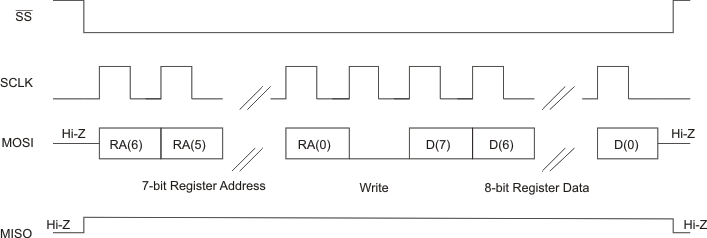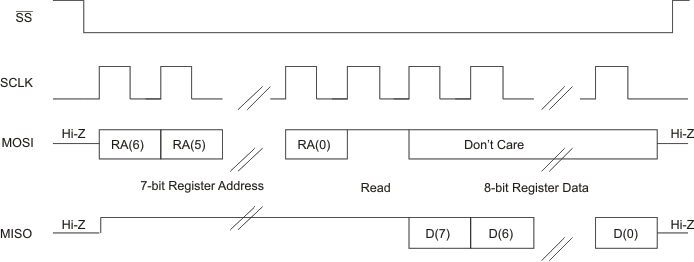SBASA12 December 2020 PCM6020-Q1
PRODUCTION DATA
- 1 Features
- 2 Applications
- 3 Description
- 4 Revision History
- 5 Device Comparison Table
- 6 Pin Configuration and Functions
-
7 Specifications
- 7.1 Absolute Maximum Ratings
- 7.2 ESD Ratings
- 7.3 Recommended Operating Conditions
- 7.4 Thermal Information
- 7.5 Electrical Characteristics
- 7.6 Timing Requirements: I2C Interface
- 7.7 Switching Characteristics: I2C Interface
- 7.8 Timing Requirements: SPI Interface
- 7.9 Switching Characteristics: SPI Interface
- 7.10 Timing Requirements: TDM, I2S or LJ Interface
- 7.11 Switching Characteristics: TDM, I2S or LJ Interface
- 7.12 Timing Diagrams
- 7.13 Typical Characteristics
-
8 Detailed Description
- 8.1 Overview
- 8.2 Functional Block Diagram
- 8.3
Feature Description
- 8.3.1 Serial Interfaces
- 8.3.2 Phase-Locked Loop (PLL) and Clock Generation
- 8.3.3 Input Channel Configuration
- 8.3.4 Reference Voltage
- 8.3.5 Microphone Bias
- 8.3.6 Input DC Fault Diagnostics
- 8.3.7
Signal-Chain Processing
- 8.3.7.1 Programmable Channel Gain and Digital Volume Control
- 8.3.7.2 Programmable Channel Gain Calibration
- 8.3.7.3 Programmable Channel Phase Calibration
- 8.3.7.4 Programmable Digital High-Pass Filter
- 8.3.7.5 Programmable Digital Biquad Filters
- 8.3.7.6 Programmable Channel Summer and Digital Mixer
- 8.3.7.7
Configurable Digital Decimation Filters
- 8.3.7.7.1
Linear Phase Filters
- 8.3.7.7.1.1 Sampling Rate: 8 kHz or 7.35 kHz
- 8.3.7.7.1.2 Sampling Rate: 16 kHz or 14.7 kHz
- 8.3.7.7.1.3 Sampling Rate: 24 kHz or 22.05 kHz
- 8.3.7.7.1.4 Sampling Rate: 32 kHz or 29.4 kHz
- 8.3.7.7.1.5 Sampling Rate: 48 kHz or 44.1 kHz
- 8.3.7.7.1.6 Sampling Rate: 96 kHz or 88.2 kHz
- 8.3.7.7.1.7 Sampling Rate: 192 kHz or 176.4 kHz
- 8.3.7.7.1.8 Sampling Rate: 384 kHz or 352.8 kHz
- 8.3.7.7.1.9 Sampling Rate: 768 kHz or 705.6 kHz
- 8.3.7.7.2 Low-Latency Filters
- 8.3.7.7.3
Ultra-Low-Latency Filters
- 8.3.7.7.3.1 Sampling Rate: 16 kHz or 14.7 kHz
- 8.3.7.7.3.2 Sampling Rate: 24 kHz or 22.05 kHz
- 8.3.7.7.3.3 Sampling Rate: 32 kHz or 29.4 kHz
- 8.3.7.7.3.4 Sampling Rate: 48 kHz or 44.1 kHz
- 8.3.7.7.3.5 Sampling Rate: 96 kHz or 88.2 kHz
- 8.3.7.7.3.6 Sampling Rate: 192 kHz or 176.4 kHz
- 8.3.7.7.3.7 Sampling Rate: 384 kHz or 352.8 kHz
- 8.3.7.7.1
Linear Phase Filters
- 8.3.8 Automatic Gain Controller (AGC)
- 8.3.9 Interrupts, Status, and Digital I/O Pin Multiplexing
- 8.4 Device Functional Modes
- 8.5 Programming
- 8.6 Register Maps
- 9 Application and Implementation
- 10Power Supply Recommendations
- 11Layout
- 12Device and Documentation Support
Package Options
Mechanical Data (Package|Pins)
- RTV|32
Thermal pad, mechanical data (Package|Pins)
Orderable Information
8.5.1.2 SPI Control Interface
The general SPI protocol allows full-duplex, synchronous, serial communication between a host processor (the master) and peripheral devices (slaves). The SPI master (in this case, the host processor) generates the synchronizing clock (driven onto SCLK) and initiates transmissions by taking the slave-select pin SSZ from high to low. The SPI slave devices (such as the PCM6020-Q1) depend on a master to start and synchronize transmissions. A transmission begins when initiated by an SPI master. The byte from the SPI master begins shifting in on the slave MOSI pin under the control of the master serial clock (driven onto SCLK). When the byte shifts in on the MOSI pin, a byte shifts out on the MISO pin to the master shift register.
The PCM6020-Q1 supports a standard SPI control protocol with a clock polarity setting of 0 (typical microprocessor SPI control bit CPOL = 0) and a clock phase setting of 1 (typical microprocessor SPI control bit CPHA = 1). The SSZ pin can remain low between transmissions; however, the device only interprets the first eight bits transmitted after the falling edge of SSZ as a command byte, and the next eight bits as a data byte only if writing to a register. The device is entirely controlled by registers. Reading and writing these registers is accomplished by an 8-bit command sent to the MOSI pin prior to the data for that register. Table 8-50 shows the command structure. The first seven bits specify the address of the register that is being written or read, from 0 to 127 (decimal). The command word ends with an R/W bit, which specifies the direction of data flow on the serial bus.
In the case of a register write, set the R/W bit to 0. A second byte of data is sent to the MOSI pin and contains the data to be written to the register. A register read is accomplished in a similar fashion. The 8-bit command word sends the 7-bit register address, followed by the R/W bit equal to 1 to signify a register read. The 8-bit register data is then clocked out of the device on the MISO pin during the second eight SCLK clocks in the frame. The device supports sequential SPI addressing for a multiple-byte data write/read transfer until the SSZ pin is pulled high. A multiple-byte data write or read transfer is identical to a single-byte data write or read transfer, respectively, until all data byte transfers complete. The host device must keep the SSZ pin low during all data byte transfers. Figure 8-71 shows the single-byte write transfer and Figure 8-72 illustrates the single-byte read transfer.
| BIT 7 | BIT 6 | BIT 5 | BIT 4 | BIT 3 | BIT 2 | BIT 1 | BIT 0 |
|---|---|---|---|---|---|---|---|
| ADDR(6) | ADDR(5) | ADDR(4) | ADDR(3) | ADDR(2) | ADDR(1) | ADDR(0) | R/WZ |
 Figure 8-71 SPI Single-Byte Write Transfer
Figure 8-71 SPI Single-Byte Write Transfer Figure 8-72 SPI Single-Byte Read Transfer
Figure 8-72 SPI Single-Byte Read Transfer